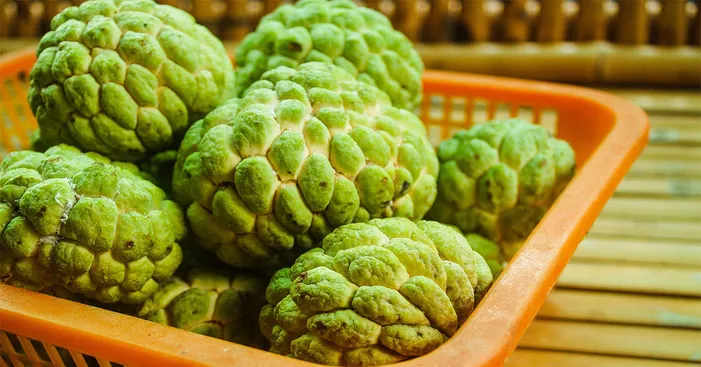
If you are looking for a sweet and exotic fruit to add to your diet, then look no further than the cherimoya fruit!
Known for its creamy texture and tropical flavor, this unique fruit is a powerhouse of vitamins, minerals and antioxidants.
In this blog post, we’ll discuss the nutrition and health benefits of cherimoya, as well as provide some tips on how to select, store and enjoy this delicious fruit.
So read on to find out everything you need to know about cherimoya!
General facts about Cherimoya:
History of cherimoya:
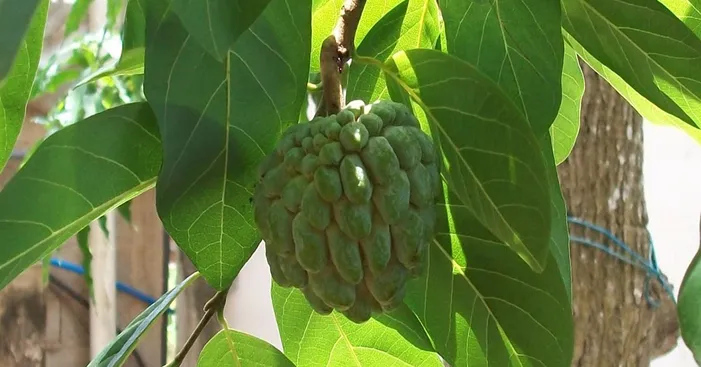
The cherimoya fruit comes from South America specifically from Peru and Ecuador where it grows on high attitudes.
Some research includes other Andean regions like Colombia and Chile as the homelands of this fruit.
It was after the discovery of the Americas that the cherimoya fruit was brought to the East side of the world.
Since Africa and Asia have similar tropical weather to the Andean regions, it was possible to cultivate this fruit.
Not only that but the cherimoya tree is also cultivated in Europe mostly on the coast of Granada in Spain.
There are even Spanish books that date back more than 400 years and mention the cherimoya fruit.
Nowadays, the main producers of this fruit are Peru, Chile, Bolivia, Spain, Argentina, South Africa, Taiwan, and the United States.
Spain is leading global production by providing more than 80% of the total cherimoya produced worldwide.
However, most of the quantities that Spain produces go into their national markets because of its bad resistance to transportation.
This fruit also requires specific climate and soil conditions which explains why can only be produced in certain regions.
In addition, the short-yielding season also plays a part in making cherimoya a very local fruit.
cherimoya fruit overview
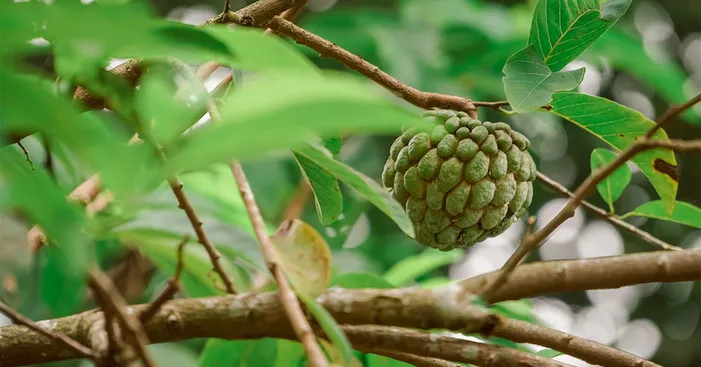
Also called “custard apple”, the cherimoya fruit goes by the scientific name “Annona cherimola”.
The fruit grows on the cherimoya tree which belongs to the Annonaceae family and counts for more than 2200 species.
These types of fruits are native to tropical regions around the world like Peru, Colombia, Vietnam, Senegal, Sudan…
However, within the same genus, “Annona” people have been cultivating more than 100 types of hybrids for human consumption.
Because of that, there are many different cultivars that people consume and refer to as “cherimoya fruit”.
Cultivated varieties of cherimoya fruit:

As mentioned above, there are 100s of varieties of cherimoya, but here are the most cultivated ones:
Mamillata:
This type offers a pronounced fragrance and offers great organoleptic qualities for those who like fruits.
People who have liked the Mamillata cherimoya said it was very juicy and it had a similar taste to pineapples.
Printed:
As the richest type in both flavor and nutritional composition, the Printed cherimoya is among the most sold types.
This fruit is called “printed” because its skin has a pattern of imprints that looks like fingerprints.
Tuberculata:
As a medium-sized cherimoya, the Tuberculata variety comes in a heart shape.
Those who tried it have described it as a combination of bananas, strawberries, and pineapple which makes it one of the tastiest fruit they have ever tried.
Ubonata:
This type of cherimoya contains the most seeds inside and has sharp points all over the skin.
The flavor of an Ubonata cherimoya is intense and it comes in a pineapple shape with medium size.
Cherimoya fruit nutritional values and health benefits:
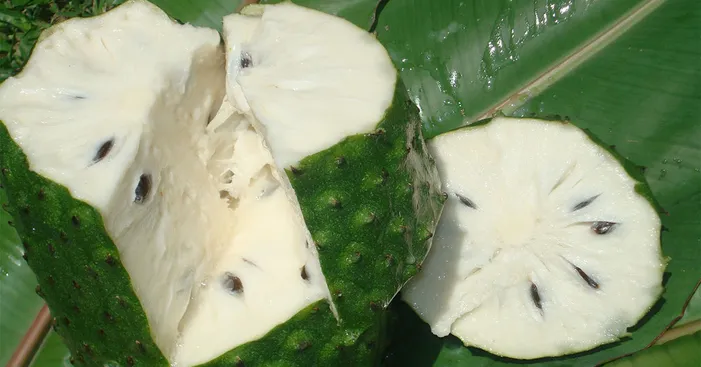
Nutritional value and properties of cherimoya
Like most fruits, the main component of cherimoya is water which represents over 70% of its weight.
This fruit also contains a good amount of carbohydrates with up to 16g per serving of ½ cup (80g).
The carbs composition comes mainly in the form of glucose, fructose, and sucrose offering respectively 12%, 25%, and 16% of the daily needs.
Because of this high sugar content, the fruit can have a medium-high caloric content with up to 60 calories per serving of ½ cup.
Nonetheless, the cherimoya fruit is very low in fat content, proteins, and sodium levels but it offers around 10% of the daily need in fibers.
As for the vitamins and minerals, the fruit offers a good amount of vitamin C, B vitamins, copper, potassium, and magnesium.
This data counts for a serving of ½ cup (almost half a fruit) of a raw cherimoya fruit (80g):

- Calorie: 60
- Protein: 1.3g
- Carbs: 14g
- Fat: 0.5g
- Fiber: 2.4g
- Sugars: 10g
- Vitamin C: 11%
- Vitamin B1: 7%
- Vitamin B2: 8%
- Vitamin B5: 6%
- Vitamin B6: 12%
- Vitamin B9: 5%
- Calcium: 1%
- Copper: 7%
- Iron: 1%
- Magnesium: 3%
- Phosphorus: 2%
- Potassium: 5%
Health benefits:

Offers great anti-microbial properties:
Being rich in antioxidants, regular consumption of cherimoya fruit can protect us from parasites.
In fact, many studies approve that the combination of fibers, cytotoxins, and vitamin C can indeed help the body get rid of parasites and bad bacteria.
Promotes cardiovascular health:
Just like bananas, cherimoya contains potassium and it offers about 5% of the daily need for this mineral.
In fact, according to studies made by the Centre for Disease Control (CDC), potassium can drop blood pressure.
As a result, the heart needs less effort to pump blood which makes it less vulnerable to strokes and heart disease.
Also, this fruit contains a lot of phenols and antioxidants which play a key role in controlling bad cholesterol levels.
May have anti-cancer properties:
Thanks to the high content of flavonoids in the cherimoya fruit, it can definitely reduce the risk of cancer.
For instance, this fruit is a good source of epicatechin, catechin, and epigallocatechin which are flavonoids with anti-cancerous properties.
According to studies, a regular intake of epicatechin shows a great reduction of cancerous cells in bladder cancer patients.
In addition, other studies show that catechin extracted from cherimoya was able to stop 100% of breast cancer growth.
It is even general knowledge that regular consumption of flavonoids is always associated with a lower risk of cancer.
This doesn’t mean that we can use fruits like cherimoya to treat cancer, but they can certainly be consumed as part of a plan to fight cancer.
Protects against osteoporosis:
Cherimoya is also a good source of many minerals including copper, calcium, and magnesium which can help with osteoporosis.
Even though a serving of ½ cup of this fruit offers 60 mcg of copper which can help reach the daily needs.
It should be noted that copper plays an essential role in collagen formation which is one of the basic structures of the bones.
Can promote weight loss:
Thanks to its high carbohydrate content, consuming cherimoya would make you feel full for a longer time.
This can be ideal for those who want to lose weight as you will be consuming a healthy and less amount of food.
Good during pregnancy:
Because of its high content of essential elements, cherimoya is also healthy and safe to consume during pregnancy.
In fact, the many nutrients of this fruit can play a role in the development of the fetus:
- Carbohydrates.
- Protein.
- Dietary fibers.
- Fats.
- Minerals.
- Vitamins.
Tranquilizing effect:
Another benefit of this fruit is the tranquilizing effect that people feel after consuming it.
According to the Mexican Ministry of Agriculture, cherimoya is a natural nervous system regulator.
This can be due to the potassium content of this fruit which can promote relaxation which is confirmed by many studies.
Regulates digestion:
Even though cherimoya is easily digested, it is also a good idea to promote smooth digestion.
This can be beneficial, especially for those who are dealing with bad digestion or dyspepsia.
It is probably due to the low-fat content as well as the good amount of dietary fibers which can absorb bile acids.
The fibers also play a laxative role and help the stomach regulate the number of gut bacteria.
Good for the eyes:
Being a good source of many antioxidants like lutein and carotenoid, cherimoya can be very beneficial for the eyes.
Many studies confirm the great effect of lutein on the eyes’ overall health and how it helps lower vision loss and eye damage risks.
For instance, lutein in particular can significantly reduce the risk of cataracts often referred to as “eye clouding”.
In fact, some studies show that people with high levels of lutein have been linked with 27% less risk of developing cataracts.
Consuming cherimoya fruits would offer carotenoids and help your body meet its daily need for lutein and reduce the risk of eye-related diseases.
Precautions before you consume a cherimoya fruit:

Even though, the pulp of cherimoya fruit is safe to consume, we should still be careful of the seeds.
The seeds are inedible and they even present a risk of intoxication which can be fatal in certain doses.
This is the case for all Annonaceae family fruits as they contain annonacin which is a toxin to the nervous system and brain.
According to many studies, there is a link between the overconsumption of Annon fruits and a higher risk of Parkinson’s.
However, the majority of this toxin is located in the seeds and skin which are both inedible.
In fact, in some parts of Latin America, they ferment the seeds of cherimoya and use them as insecticides.
Therefore, to enjoy this fruit make sure you get rid of the skin and the seeds and only enjoy the refreshing pulp.
Nonetheless, those who already deal with Parkinson’s or have any concerns probably should just avoid eating cherimoya.
How to consume and use it in the kitchen
Just like any fruit, the best way to eat cherimoya is to snack on it chopped or using a spoon.
The seeds of a cherimoya fruit are big like watermelon seeds so you can easily dismiss them.
Using a sharp knife, you can peel the skin of a custard apple just like you peel an orange.
There is another easier way, you can cut a cherimoya in halves and consume its insides using a spoon like an avocado.
In addition, overripe cherimoya may look dark but they are, like bananas, totally safe to consume.
The dark color looks repelling for some people but it’s just the result of air exposure which speeds up oxidation.
However, if you want to avoid that you can sprinkle lemon juice on the pulp and keep it in an airtight container.
As for kitchen use, you can mash the pulp and use it in sauces, stews, sweet pastes, mousses, and dressings.
This can be very beneficial for those who are trying to avoid refined sugar and use natural fruit sugar like the one in cherimoya.
Also, this fruit can also be used in savory dishes to replace coconut milk or creams.
As this fruit ripens, the pulp becomes firmer and can be mushed into a paste which we can use in fruit salads, on top of cakes, and as stuffing for muffins.
Cherimoya sorbet:
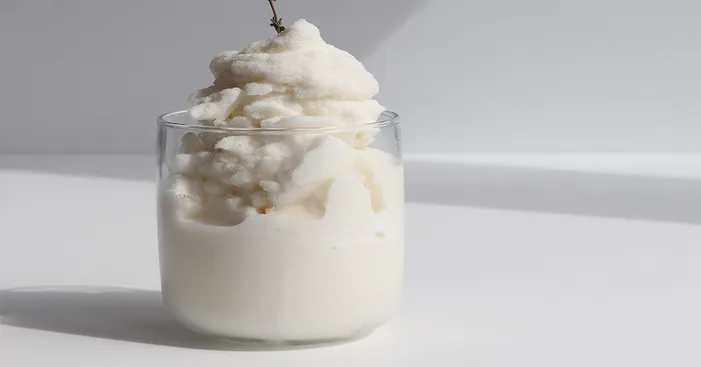
Ingredients:
- 1 cup of water.
- 4 cherimoya fruits.
- 1.5 cups of sugar (300g).
- 1 lemon.
Preparations:
- Start by peeling the cherimoya then cut it into small pieces and make sure you take out all the seeds.
- In a bowl, juice the lemon then add the cherimoya pieces and crush it with a fork to obtain a puree.
- Pour the water and sugar into a pot and start cooking it until it starts boiling and start thickens.
- Let the syrup cool down then mix it with the cherimoya puree and stir until you obtain a homogenous mixture.
- Pour the mixture into cups or molds of your choice before you place it in the coldest part of your fridge.
- Once it freezes, you can enjoy it with your loved ones!
Cherimoya pudding:
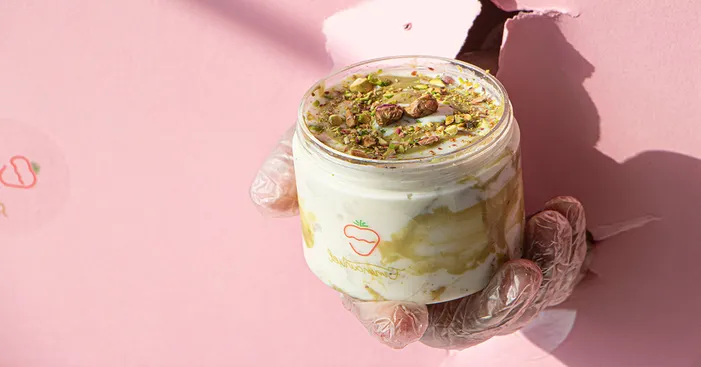
Ingredients:
- 2 cherimoya fruits.
- ½ cup of almond milk.
- 1 ounce of crushed pistachios (28g).
- A pinch of salt.
Preparation:
- As a common starting point, peel off the cherimoya fruits then cut them into pieces before you get rid of all the seeds.
- Put the pieces of cherimoya in a blender with almond milk and salt then blend for 30 seconds.
- Put the mixture in cups then place it in the freezer for at least 1 hour.
- Once it has an ice cream consistency, top it with crushed pistachios and serve it!
Fruit salad:

Ingredients:
- 1 cherimoya fruit.
- 2 tbsps of lemon juice.
- 1 banana.
- 12 strawberries.
- 4 mint leaves.
- 1/2 cup of water.
Preparation:
- Peel off the cherimoya fruit and cut it into small pieces then take off the seeds.
- In a bowl, mix the pieces of cherimoya with lemon juice and water then mix it into a puree using a fork.
- Put the bowl in the fridge for 4 hours while mixing it every half an hour to ensure a finer consistency.
- Peel the banana then cut it and the strawberries into bite sizes then put these small pieces into cups.
- Stir the cherimoya puree one last time and use it as a garnish on top of the fruit cups, decorate it with mint leaves, and enjoy it!
Buying cherimoya:

As a tropical fruit, the cherimoya fruit continues to ripen even after harvesting just like avocados.
Despite the thickness of the skin, the pulp inside can be overripe already which could look darker and taste sweeter.
Because of that, the first buying tip is to buy cherimoya with slightly green skin which will be firm and can be kept for a longer time.
Because of its low resistance to transportation, you are more likely to find nationally produced cherimoya.
That is always a better choice because you can find clear labels that show you the date of harvesting and the origins.
In order to buy good quality cherimoya, start to buy checking the way they are being presented.
In some markets, the cherimoya fruit is presented with special protections and does not pile up to minimize spoilage.
As for the size, try to aim for a medium-sized fruit with light green smooth skin without any bumps or dark areas.
When you hold a good quality cherimoya in your hand, it should feel firm not too mushy, and certainly not too hard.
As they keep ripening after you buy them, you’ll notice that the fruit becomes softer and softer.
How to preserve cherimoya:

Because it is a fast-ripening fruit, it must be well stored under specific conditions to avoid spoilage.
Buying a good cherimoya can be the first time of promoting its conservation!
Getting light green cherimoya fruits that yield slightly to the finger pressure will guarantee a longer shelf life.
One misconception about cherimoya is that we should store it, like any other fruit, in the fridge.
You shouldn’t keep cherimoya fruits in the fridge because the cold temperature can drastically affect the quality.
Once it ripens, the skin of the custard apple starts turning black even though it will still be totally safe for consumption.
The best thing about it though is the thick skin which can preserve it for up to 7 days.
To store cherimoya fruit the best way is to put them in a paper bag at room temperature in an airy place.
Make sure the fruit is far from other fruits or any heat sources or direct sunlight.
This is because some fruits emit ethylene which accelerates the ripeness of cherimoya in the same way it does to avocado.
